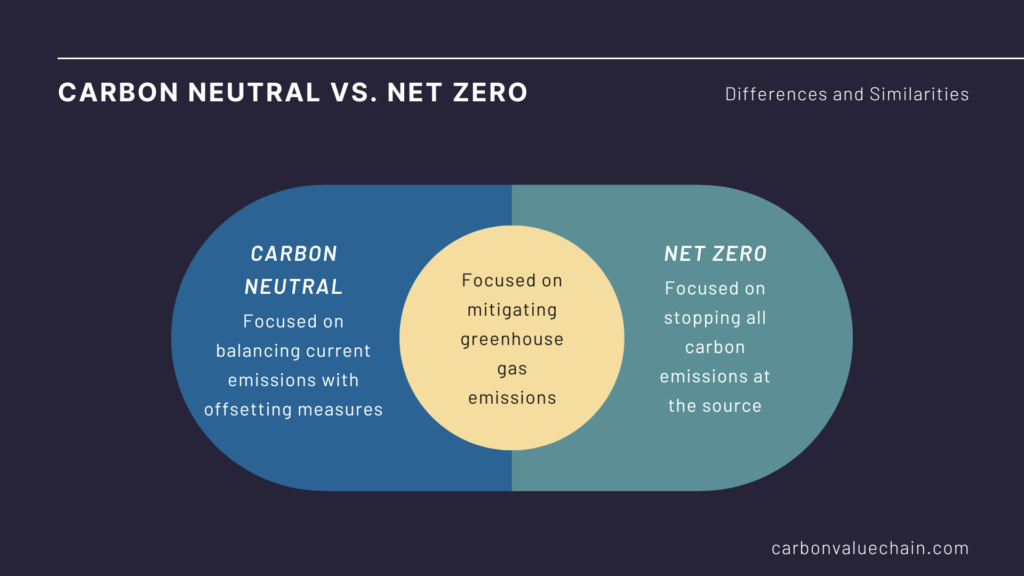Carbon Neutral vs. Net Zero: What Is the Difference?

In the era of climate change awareness and environmental responsibility, terms like “carbon neutral” and “net zero” have gained prominence. Both concepts are pivotal in the global effort to combat greenhouse gas emissions and mitigate climate change. However, they are not interchangeable.
In summary, carbon neutral means that you have compensated for carbon emissions, while net zero means that you have stopped emitting carbon altogether. This article delves further into the differences between carbon neutrality and net-zero emissions, shedding light on their unique roles in environmental sustainability.
Key Distinctions
The key distinctions between carbon neutrality and net zero are:
- Timeframe: Carbon neutrality focuses on balancing emissions in the present, while net zero is a future-oriented approach that aims to reduce emissions as much as possible.
- Emphasis on Reduction: Net zero places a stronger emphasis on reducing emissions at the source, while carbon neutrality relies more on offsetting emissions.
- Aspirational Goals: Net zero often involves setting ambitious targets with clear deadlines, whereas carbon neutrality aims to maintain a neutral environmental impact without specific time constraints.
Carbon Neutral: Balancing the Equation
To comprehend the difference between carbon neutral and net zero, it’s crucial to first grasp what each one represents. Carbon neutrality, often referred to as climate neutrality, is a state in which an individual, organization, or even a nation has effectively balanced the amount of carbon dioxide (CO2) emissions released into the atmosphere with an equivalent amount of CO2 removed or offset. In simpler terms, it’s akin to an environmental balancing act.
Read more: Carbon Offsetting Infographic: Everything You Need to Know about Carbon Offsets
Achieving carbon neutrality typically involves a two-step process. First, one must calculate the total carbon emissions produced by a particular activity, product, or entity. This calculation encompasses not only direct emissions (like those from burning fossil fuels) but also indirect emissions throughout the entire lifecycle (such as manufacturing and transportation). Then, emissions can be offset by investing in activities that remove or reduce an equivalent amount of CO2 from the atmosphere, such as afforestation projects or carbon capture and storage initiatives.
The ultimate goal of carbon neutrality is to ensure that the net impact on the environment, in terms of carbon emissions, is zero. It’s a commendable step toward environmental responsibility and often serves as a foundational strategy for entities looking to contribute positively to the fight against climate change.
Net Zero: A Forward-Looking Approach
While carbon neutrality strives to balance the carbon equation in the present, net zero takes a more forward-looking stance. Net zero, short for “net-zero emissions,” signifies the ambition to reduce greenhouse gas emissions to the lowest possible level and then compensate for any remaining emissions by removing an equivalent amount of greenhouse gasses from the atmosphere. It’s essentially an aspirational target for a sustainable future.
The critical difference between carbon neutrality and net zero lies in the emphasis on emission reduction. In a net-zero scenario, the primary focus is on minimizing emissions at their source, rather than relying heavily on offsetting measures. This means transitioning to cleaner energy sources, adopting more efficient technologies, and implementing sustainable practices to significantly reduce emissions.
Net-zero commitments often come with stringent timelines. Many countries, companies, and organizations have set ambitious targets to achieve net-zero emissions by a specific year, such as 2050. These targets require not only immediate action but also long-term planning and investments in innovative solutions for emission reduction.
In general, carbon neutrality is easier to achieve than true net zero, as it is focused simply on balancing existing emissions, rather than cutting them out.
A carbon negative approach takes a net zero approach one step further by working not only to stop emitting any carbon, but also to actively remove carbon from the atmosphere through a variety of strategies (for example, direct air capture or reforestation).
Comparing the Two: The Difference Between Carbon Neutral and Net Zero
To better illustrate the differences, let’s consider an analogy. Imagine a leaking boat as a metaphor for carbon emissions. Carbon neutrality would involve patching the leaks and ensuring that the water entering the boat equals the water being removed. It maintains the current state. On the other hand, net zero goes further by actively bailing out the water from the boat, aiming to make it completely dry over time. It’s a proactive, long-term approach to prevent the boat from sinking.
Both concepts are valuable tools in the fight against climate change. Carbon neutrality can serve as a stepping stone for organizations and individuals to kickstart their sustainability efforts, while net zero represents a higher level of commitment and ambition in reducing emissions and securing a sustainable future for our planet.
Read more: What Is Carbon Neutral Shipping? A Complete Guide
